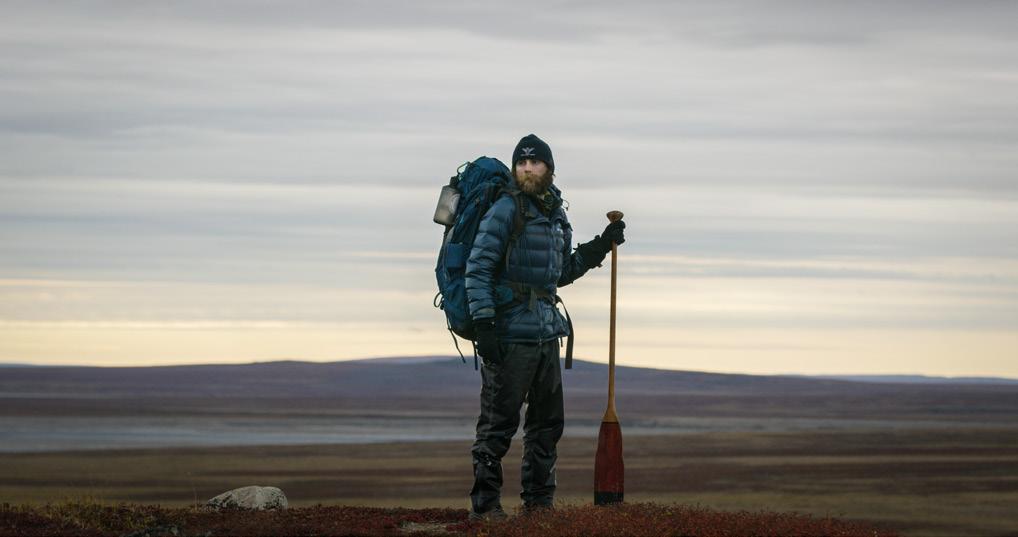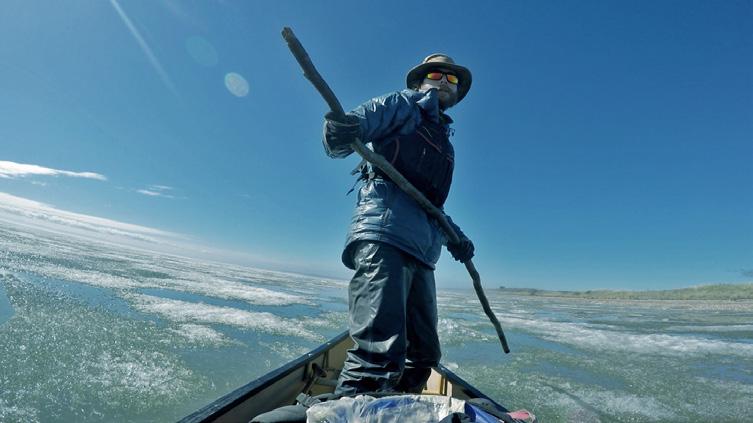
5 minute read
Alone Across The Artic
2
By Jeremy Benning csc, Martin Wojtunik and Mike Reid
Photos: PICTUREHAUSFILMS
Documentary filmmaking is often an exercise in remote logistics planning involving a very small team. Looking back on how we made this film, it reminds us of astronauts getting trained on how to use cameras in space, not only the technical aspect of it, but also getting them to think of how to tell a story with a lens. Our hero subject was essentially our spaceman. Director Francis Luta and DP Jeremy Benning csc had made a short documentary about professional explorer and best-selling author Adam Shoalts (dubbed “Canada’s Indiana Jones” by the Toronto Star) in 2015 called Explorer, which was the beginning of our relationship with him. This evolved into Adam asking us to make a feature doc about his sesquicentennial solo trek across the Arctic. Between the months of May and September 2017, over 100 days, Adam would traverse some 4000 km from west to east on foot and canoe alone. The terrain was radically diverse, from lakes (some with ice breakup), rivers, rapids, creeks, rocks, mud, sand, tundra, morass, hills – the full gamut. And bugs. Clouds of mosquitos, black flies and so on. Adam had been meticulously planning this trek for years, and he was doing it regardless of the film being made. As a completely indie film, the steep

(L-R) Adam Shoalts, Mike Reid and Francis Luta filming near the mouth of Thelon River in Nunavut.

Top photo and above, Adam Shoalts.
GoPro footage of Adam Shoalts in the film Alone Across the Arctic.

Jeremy Benning csc.

Martin Wojtunik shooting along Dempster Highway, NWT. travel costs of sending our micro teams into the north meant we could only manage doing this for three short points over the course of Adam’s journey – beginning send-off, middle supply drop and the end. Working as a team, Jeremy, Francis, Martin and Mike split up the tasks of who would shoot what and how. All of us took turns shooting various aspects of the film, with Adam handling all the solo expedition footage. Our first mission was to work with Adam in prep to determine the size of camera kit he could manage to carry along with his 54lb custom Nova Craft canoe, two supply barrels and a backpack. Mike suggested the Sony AX100 4K camcorder, along with two GoPros. Adam had given us an ultimatum of 5.0lbs of camera gear. This gear that Adam would carry had to serve a few purposes – tell the story in the best quality possible while also being lightweight with excellent battery life and efficient storage media. We set up the Sony camera so that Adam could turn it on and all he had to do was hit record and frame himself off of the flip screen. To test the gear in similar conditions that Adam would encounter, and determine how many batteries and cards he would need, Mike used the AX100 daily for a few weeks, recording about an hour at a time and keeping it and its batteries in his fridge between uses. The GoPros and Sony AX100 could be charged (very slowly) off of a USB solar panel. We asked Adam to try shooting an average of 30 minutes per day in order to ration cards while also giving us enough footage to fully express the breadth of his journey. Another challenge we were faced with as filmmakers was that because we had to lean on Adam so much to capture the main story’s visuals with consumer-grade cameras, the responsibility to set the tone for his trek with

various traditional cine cameras (RED and Canon) carried much more weight for us. We only had three points in the journey where we were afforded the opportunity to paint our canvas as cinematographers, as Adam’s shooting was going to be mostly testimonials and POV style of filming. To set the film’s tone, we employed vast wide-angle vistas, moody, brooding countryside shots and extensive drone work to not only showcase scale but to also lay out the daunting scope of Adam’s mission. During prep, Francis worked with Adam to think about his shots, to ensure he captured wides, moments of quiet, and so on. For a man who would be focused on an intense trek, the visual storytelling requirement to make an engaging film may not have always been his first priority. Director Francis Luta piggybacked onto the midtrek supply drop float plane, which Adam had already chartered. Francis flew three hours north from Yellowknife with local DJI Inspire drone op Pablo Saravanja to meet Adam on the Coppermine River. Canon Canada donated an XC10 4K camcorder for Francis to use; this was the camera he carried when he was alone with Adam or when Martin or Mike were tagging along with their full-size cameras. One of the more nerve-wracking aspects of making this film was not being able to see the footage or check it until the mid-trek supply drop where Francis was able to trade media cards and batteries with Adam. Thankfully, Adam followed his prep training by Francis, Martin and Mike on how to shoot, and we were blessed with well-framed, sharp, well-exposed footage – and good in-camera sound! Using text messaging over a satellite phone, Francis was able to send Adam notes on the first leg footage, with tips on what to capture more of, framing, talking points, etc. As a team, all of us were incredibly impressed with the calibre of footage Adam managed to capture, all whilst braving the elements and physical demands of achieving his finish line goal in Baker Lake, Nunavut.

Like Night and Day
Specially designed for high-end professional movie, TV and commercial productions, the new Nanlux Dyno series of 650C and 1200C of premium ultra-bright RGBWW softlights offer superior output in a rugged compact form factor.
• Fully tunable with an impressive 2700 to 20,000K CCT range • Industry-leading output at 2649 and 5596 Lux, respectively • Consistent flicker-free illumination with super-precise 0 to 100% dimming • User-friendly menu controls on a large 4.3-inch display • 15 customizable effects and an extensive gel library • Built-in DMX, WiFi, Bluetooth and LumenRadio • Highly portable and easy to manage on set
They’re not only easy to transport but also much more affordable than comparable products in this class. The Nanlux Dyno 650C and 1200C really have to be seen to be believed. For more information, contact Vistek’s Commercial Solutions Group at 416-644-8010.







